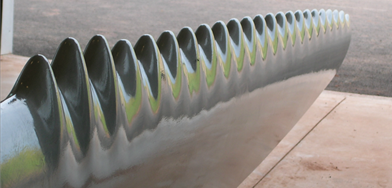The humpback whale (Megaptera novaeangliae) is exceptional among the large baleen whales in its ability to undertake aquabatic maneuvers to catch prey. Humpback whales utilize extremely mobile, wing-like flippers for banking and turning. Large rounded tubercles along the leading edge of the flipper are morphological structures that are unique in nature. The tubercles on the leading edge act as passive-flow control devices that improve performance and maneuverability of the flipper.

humpback whale
Experimental analysis of finite wing models has demonstrated that the presence of tubercles produces a delay in the angle of attack until stall, thereby increasing maximum lift and decreasing drag. Possible fluid-dynamic mechanisms for improved performance include delay of stall through generation of a vortex and modification of the boundary layer, and increase in effective span by reduction of both spanwise flow and strength of the tip vortex. The tubercles provide a bio-inspired design that has commercial viability for wing-like structures. Control of passive flow has the advantages of eliminating complex, costly, high-maintenance, and heavy control mechanisms, while improving performance for lifting bodies in air and water. The tubercles on the leading edge can be applied to the design of watercraft, aircraft, ventilation fans, and windmills.

Surfboard skeg based on leading-edge tubercles of the humpback whale’s flipper

Bionic windmill blade
Information Source: https://academic.oup.com/icb/article/51/1/203/636829

